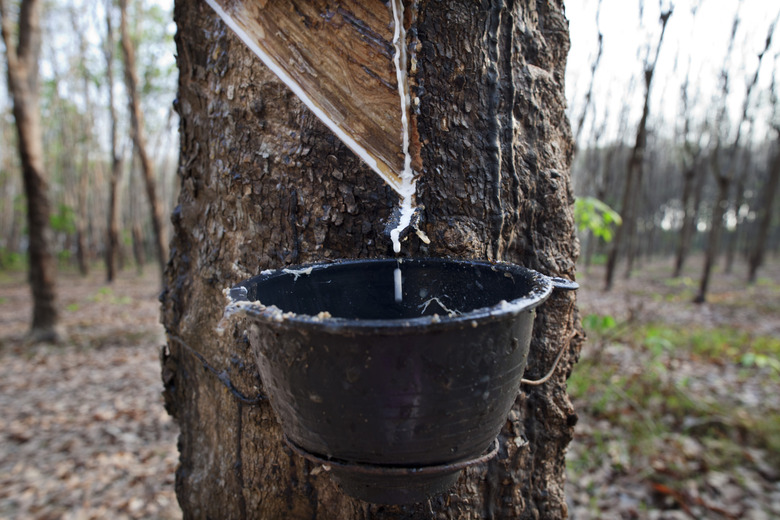Diseases Of Ficus Elastica
Ficus elastica, more commonly known as the rubber tree, is a tropical-looking plant that thrives outdoors only in very warm climates, including U.S. Department of Agriculture plant hardiness zones 10 and 11. Gardeners living in cooler areas frequently enjoy growing rubber trees as houseplants, however. Although serious pest or health problems aren't associated with this undemanding evergreen, you should still keep an eye out for a few minor plant diseases that might affect your specimen.
Anthracnose
Step 1
Rubber trees occasionally suffer from anthracnose, a fungal disease that thrives in moist growing conditions. Anthracnose initially causes greasy-looking, yellow spots to form on leaves and tan or red-brown sores to appear along the major veins. The infected plant tissue usually dies, causing the affected leaves to curl up or become misshapen. Premature leaf drop frequently occurs with severe anthracnose infections.
- Ficus elastica, more commonly known as the rubber tree, is a tropical-looking plant that thrives outdoors only in very warm climates, including U.S. Department of Agriculture plant hardiness zones 10 and 11.
- The infected plant tissue usually dies, causing the affected leaves to curl up or become misshapen.
Leaf Spots
Step 1
Rubber trees attract few bacterial pathogens, but occasionally contract Xanthomonas leaf spot. The bacterium enters the plant through injuries or the plant's natural breathing pores, called stomata, and then spread throughout the plant tissue. Early symptoms include tiny, water-soaked spots appearing on the leaves. These spots quickly enlarge and merge, sometimes developing irregular, bright yellow borders near the leaf edges. Cercospora leaf spot disease causes very small, slightly raised, dark green or red spots to develop on the undersides of leaves. These spots typically have gray centers and distinct yellow halos. Heavily infected leaves often shrivel and turn brown or yellow. Any type of severe leaf spot infection can cause your rubber tree to lose its leaves early in the growing season.
- Rubber trees attract few bacterial pathogens, but occasionally contract Xanthomonas leaf spot.
Blights
Step 1
Like other Ficus species, rubber trees sometimes attract the fungal pathogens that cause blight disease. Southern blight, also called crown rot or southern stem rot, attacks plants just beneath the soil line, causing the rubber tree's crown to rot and the leaves to yellow, wilt, collapse and even die. Humid weather promotes a white, cottony growth that spreads across the soil and stems. Botrytis blight attacks the plant's leaves, causing large, soft, brown-colored spots to form on the foliage. The affected leaves frequently develop a layer of gray mold after stretches of cool, moist weather.
Chemical Preventative Methods
Step 1
Rubber tree diseases can be difficult to control once established, so a preventative approach is typically your best option. Start treatment on outdoor plants when your local weather forecast predicts a long stretch of wet, rainy weather, and begin spraying houseplants as soon as you spot disease symptoms. Repeat applications every seven to 10 days until the conditions no longer favor ficus diseases. Spraying healthy rubber tree foliage with a mancozeb-based fungicide can help prevent anthracnose, blights and fungal leaf spot diseases. Combine about 3 teaspoons of product into 1 gallon of water, mix well in a handheld sprayer and apply until the foliage glistens with moisture. Using a copper-based bactericide often works effectively as a preventative measure against bacterial leaf spot. Mix between 1/2 to 2 fluid ounces of product into a gallon of water. Thoroughly spray the tops and undersides of rubber tree leaves for the best results.
- Like other Ficus species, rubber trees sometimes attract the fungal pathogens that cause blight disease.
- Spraying healthy rubber tree foliage with a mancozeb-based fungicide can help prevent anthracnose, blights and fungal leaf spot diseases.
Considerations
Step 1
Rubber trees feature thick, leathery, glossy leaves that reach up to 1 foot long. Although the exotic-looking foliage lends a tropical touch to your home environment, the leaves ooze a milky sap that can cause stomach upset and skin irritation if ingested or touched. Avoid problems by locating your rubber tree in an area away from young kids and pets. Always carefully read and follow the application instructions and safety precautions on a fungicide or bactericide product's label.
References
- U.S. Forest Service Department of Agriculture: Ficus Elastica
- University of Florida IFAS: Ficus Production Guide
- Clemson Cooperative Extension: Rubber Plant
- University of Florida IFAS Extension: Anthracnose Disease of Ornamental Plants: A Pictorial
- Penn State Extension: Ficus Diseases
- Missouri Botanical Garden: Crown Rot of Perennials (Southern Blight)
- Missouri Botanical Garden: Botrytis Blight
- University of Florida IFAS Extension: Cercospora: A Summer Fungal Disease Problem
- The Connecticut Agricultural Experiment Station: Leaf Spot Diseases of Ornamental Trees and Shrubs
